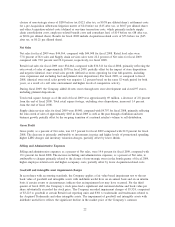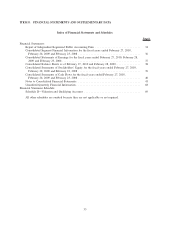Albertsons 2010 Annual Report Download - page 32
Download and view the complete annual report
Please find page 32 of the 2010 Albertsons annual report below. You can navigate through the pages in the report by either clicking on the pages listed below, or by using the keyword search tool below to find specific information within the annual report.variable factors including inflation, the general health of the economy and market competition. The Company
has sufficient current and historical information available to support its judgments and estimates. However, if
actual results are not consistent with the Company’s estimates, future operating results may be materially
impacted.
For the fourth quarter ended February 27, 2010, the review of goodwill for impairment indicated that the fair
value for one reporting unit with $2,754 of goodwill exceeded the carrying value by less than 5 percent and
the fair value for another reporting unit with $807 of goodwill exceeded the carrying value by greater than
10 percent. The remaining $136 of goodwill is at a reporting unit with fair value that substantially exceeds the
carrying value. If the Company’s stock price experiences a significant and sustained decline, the Company
would reassess the fair value of the implied goodwill compared to the carrying value.
The Company also reviews intangible assets with indefinite useful lives, which primarily consist of trademarks
and tradenames, for impairment during the fourth quarter of each year, and also if events or changes in
circumstances indicate that the asset might be impaired. The reviews consist of comparing estimated fair value
to the carrying value. Fair values of the Company’s trademarks and tradenames are determined primarily by
discounting an assumed royalty value applied to projected future revenues associated with the tradename based
on management’s expectations of the current and future operating environment. The royalty cash flows are
then discounted using rates based on the weighted average cost of capital discussed above and the specific risk
profile of the tradenames relative to the Company’s other assets. These estimates are impacted by variable
factors including inflation, the general health of the economy and market competition. During fiscal 2010, the
Company recorded impairment charges of $20 to its Acquired Trademarks as a result of certain market exits.
During fiscal 2009, the Company recorded impairment charges of $301 to its Acquired Trademarks as a result
of its review for impairment.
For the fourth quarter ended February 27, 2010, the review of intangible assets with indefinite useful lives for
impairment indicated that the fair value for certain Acquired Trademarks approximated the carrying value of
$970 due to the impairment charges recorded in fiscal 2010 and 2009. The fair value for the remaining $79 of
intangible assets with indefinite useful lives substantially exceeds the carrying value. If the variable factors
discussed above change significantly, the Company would reassess the fair value of the intangible assets with
indefinite useful lives compared to the carrying value.
Self-Insurance Liabilities
The Company is primarily self-insured for workers’ compensation, healthcare for certain employees and
general and automobile liability costs. It is the Company’s policy to record its self-insurance liabilities based
on management’s estimate of the ultimate cost of reported claims and claims incurred but not yet reported and
related expenses, discounted at a risk-free interest rate.
In determining its self-insurance liabilities, the Company performs a continuing review of its overall position
and reserving techniques. Since recorded amounts are based on estimates, the ultimate cost of all incurred
claims and related expenses may be more or less than the recorded liabilities. Any projection of losses
concerning workers’ compensation, healthcare and general and automobile liability is subject to a degree of
variability. Among the causes of this variability are unpredictable external factors affecting future inflation
rates, discount rates, litigation trends, legal interpretations, regulatory changes, benefit level changes and actual
claim settlement patterns. The majority of the self-insurance liability for workers’ compensation is related to
claims occurring in California. California workers’ compensation has received intense scrutiny from the state’s
politicians, insurers and providers. In recent years, there has been an increase in the number of legislative
reforms and judicial rulings affecting the handling of claim activity. The impact of many of these variables on
ultimate costs is difficult to estimate. The effects of changes in such estimated items are included in results of
operations in the period in which the estimates are changed. Such changes may be material to the results of
operations and could occur in a future period. If, in the future, the Company was to experience significant
volatility in the amount and timing of cash payments compared to its earlier estimates, the Company would
assess whether to continue to discount these liabilities. The Company had self-insurance liabilities of
26
























